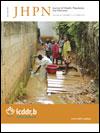Constructing Indices of Rural Living Standards in Northwestern Bangladesh
DOI:
https://doi.org/10.3329/jhpn.v28i5.6160Keywords:
Health, Living standards, Socioeconomic status, Wealth index, BangladeshAbstract
This study aimed to construct indices of living standards in rural Bangladesh that could be useful to study health outcomes or identify target populations for poverty-alleviation programmes. The indices were constructed using principal component analysis of data on household assets and house construction materials. Their robustness and use was tested and found to be internally consistent and correlated with maternal and infant health, nutritional and demographic indicators, and infant mortality. Indices derived from 9 or 10 household asset variables performed well; little was gained by adding more variables but problems emerged if fewer variables were used. A ranking of the most informative assets from this rural, South Asian context is provided. Living standards consistently and significantly improved over the six-year study period. It is concluded that simple household socioeconomic data, collected under field conditions, can be used for constructing reliable and useful indices of living standards in rural South Asian communities that can assist in the assessment of health, quality of life, and capabilities of households and their members.
Key words: Health; Living standards; Socioeconomic status; Wealth index; Bangladesh
DOI: 10.3329/jhpn.v28i5.6160
J HEALTH POPUL NUTR 2010 Oct;28(5):509-519
Downloads
280
158

